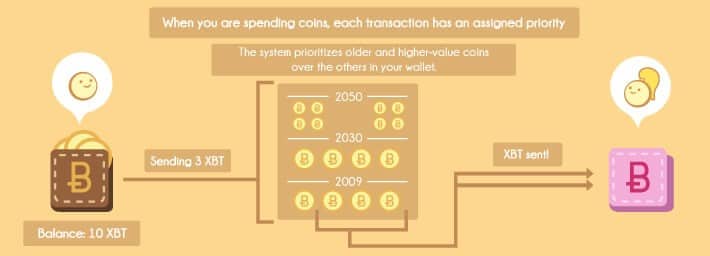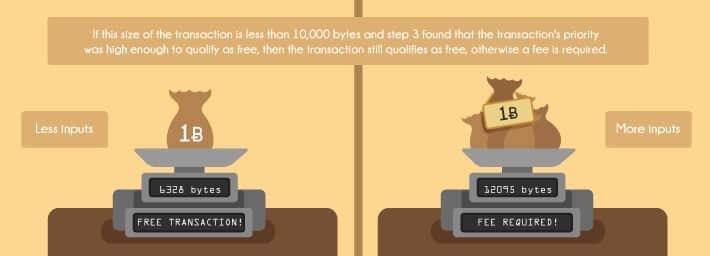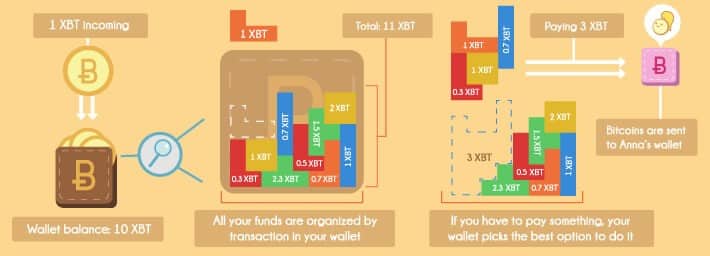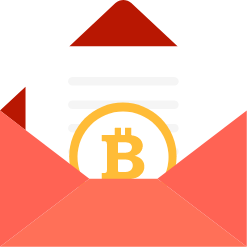This video contains advanced concepts that were explained in previous videos. If you are new to Bitcoin it’s best to watch the previous tutorials before watching this one.
One of the major advantages of Bitcoin is that you can supposedly send money between any two points on earth for free. But if you’ve sent Bitcoins once or twice before you probably noticed that there are in fact transaction fees – so what’s going on here exactly ?
Before I explain how fees are calculated I want to explain what Bitcoin fees are. When miners order transactions into blocks inside the Blockchain they get paid twice – The first payment is by what you would call “the system” – which grants them a bounty for succeeding in entering their block of transactions. The second payment is the fees the users attached to the transactions that got included in that block.
But you don’t always have to pay these fees, there are certain rules that dictate if and when you need to pay them. Of course you can choose to disregard the rules and not attach a fee to your payment but it is then possible that your transaction will take a long time to be processed.
Rule #1 – Smaller amounts pay a fee
If the numbers of Bitcoins you are sending is smaller than 0.01 Bitcoins you will be required to pay a miners’ fee. This fee is required in order to prevent users from spamming the network with micro transactions.
Even if the whole transaction is more than 0.01 Bitcoins but the change you get back from your inputs is more than 0.01Bitcoins you will need to pay a fee.
Here’s a short example:
Let’s say you want to buy a watch for 1.999 Bitcoins. You use an input of 2 Bitcoins and receive back an input of 0.001 Bitcoins as change. Since the change is such a small amount you will require to pay an additional miner’s fee for it as well.
Rule #2 – Older coins have less fees
If the inputs you are sending in your transaction are older then there is a greater chance they won’t require a fee. Old coins means coins that haven’t been moved for a long time.
Rule #3 – Smaller transactions require less fees
Each transaction is made out of inputs. The less inputs used to compile a transaction, the less fees will be required. So if you are send 1 Bitcoin and use 4 inputs of 0.25 Bitcoins it is more likely that this will require a fee then if you were to send just 1 input of 1 Bitcoin.
Keep in mind that most times you won’t have that much control over whether your transaction requires fees or not. Your Bitcoin wallet will usually make the optimization of inputs for you so you will avoid fees when possible. Today’s miner fee is 0.0001 Bitcoin which is around $0.06 and is probably worth paying to get your transaction processed quickly.
The information in this post was built using the knowledge of AlefBit (Hebrew website) and BitcoinFees – Both amazing sources for Bitcoin information.







I bought a small amount of bitcoins a few days ago but I left 30% of the amount I invested in transaction fees… is this possible? With that avgs nobody will never consider to buy btcs…
Hi Matteo,
Yes, it’s possible if you bought a small amount. The average fee for regular, small-sized Bitcoin transaction is currently around $5.25. That’s if you don’t mind waiting up to 7 hours. Faster confirmations and a bigger-sized transaction will be more expensive.
So, if you were sending about $15 worth of Bitcoin, then sure your fees could be as high as 30%. There are 2 major points to note here:
1) You’ll still pay $5.25 even if you move $15 billion worth of Bitcoin. The fee is flat, so the more value you send the less of a % you pay.
2) Using a SegWit-enabled wallet would reduce your fee by about 50 – 75%. Obviously it’s worth upgrading to SegWit wallets. If everyone did, fees would fall even further, perhaps bringing the average fee back below $1.
i have a bitcoin wallet where the fees is higher then the balance, should i just forget about it and treat it like a lost investment.
Hey Sparkes25,
No, not at all. Fees rise and fall, depending on the demand for making transactions. Fees have been very high recently but they’re now falling back to a more normal range. There is also an effort to push SegWit adoption; this seems to be succeeding so if SegWit transactions become the norm then fees should fall significantly. I would suggest that you use SegWit-enabled wallets and exchanges yourself to help in this.
Of course, the possibility of moving those coins will depend on the amount. I’m assuming that the amount is something above $10 or so. If you’re talking a few Satoshis (ie. dust) then yes, it will probably never make economic sense to send those.
Still, no matter the amount, if you do continue to use that wallet to receive bitcoins, then whatever is in the address now can go towards paying fees on future transactions.
I bought 1 LTC yesterday, however my coinbase wallet says the LTC transaction is “pending”; I called the bank and Coinbase has not tried to take money out for this. Does Litecoin have a different way of buying than bitcoin, and will profits and or debits be added or subtracted to my account while this purchase is still pending?
Hi Sheri,
As far as I know, the process should be exactly the same as for buying Bitcoin. It’s probably just a “normal” delay. If it doesn’t resolve within a few days, then I recommend contacting Coinbase customer support… As their support sometimes takes a while, you could consider contacting your bank and their bank at the same time.
Pls help. What happens when the system generates a transaction fee and yet the miners refuse to confirm for more than 6days? Pls Reply Alexander….
Hi Henry, if the miners are not confirming it, the transaction will be rejected and you will be able to see it in your wallet again after couple of days.
Llevo 10 días esperando que se confirme la transacción, tampoco ha sido rechazada podría hacer algo
Hi Santiago, your transaction is probably pending because of the low fee. Eventually, it will be transferred, but you can also use ViaBTC services to include your transaction in the next block for an extra fee.
While I agree Bitcoin’s fees are next to nothing, there are still fees. They say they have no fees attached but anyone who has even the slightest financial knowledge knows this is next to impossible. You pay only a fraction of what you would have paid if you made a bank transaction or if you used an ATM so it’s all good in the end.
It’s interesting how they went around it and decided to use smaller fees for Bitcoins that haven’t been used in a while. This stimulates users to use their coins and keep them circulating. I’m curious how long is actually considered “old”, is this something known or it’s determined by your wallet?
Andrew, you got it the other way around. Older coins – coins that have been laying around for long, don’t pay fees. This actually stimulates users to not move coins around all the time. For the technical explanation about coin age just Google “Bitcoin coin age” and you can find Bitcoin Wiki articles explaining the exact formula.